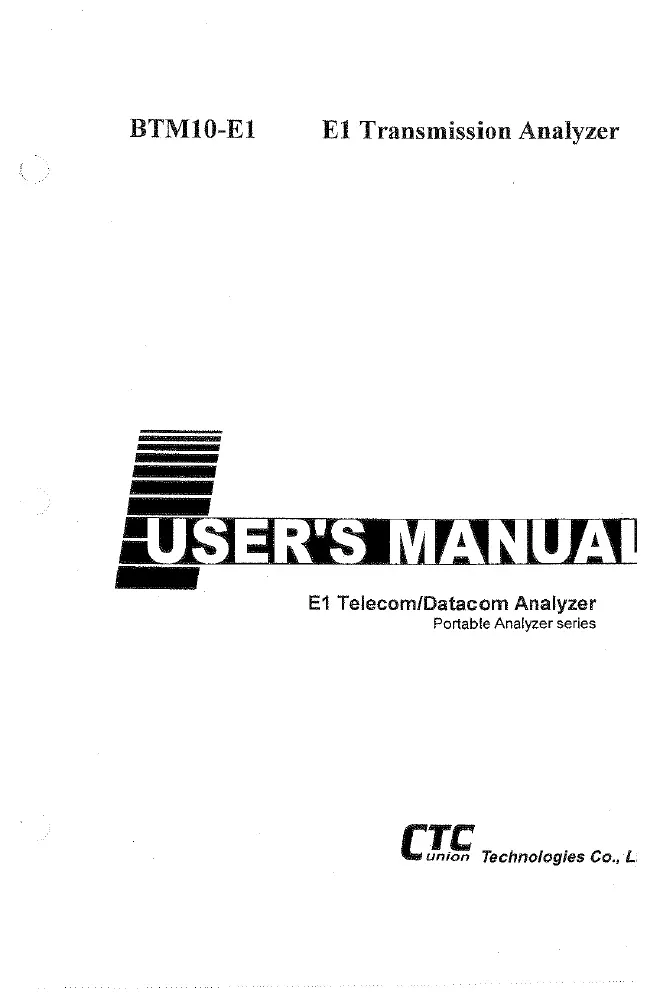CTC Union Technologies - BTM10-E1 - Analyzer
Manufacturer:
No picture available!
Maybe you can
upload a pic
for the
CTC Union Technologies BTM10-E1 ?
If you have any other manuals for the
CTC Union Technologies BTM10-E1
you can
upload the files here.
.
Equipment:
BTM10-E1
Date:
Category:
Group:
Sub Group:
Information
The BTM10 series analyzer is a compact, notebook sized PCM
measuring instrument designed for field use in analysis and
maintenance of E1 (2.048Mbps) or T1 (1.544Mbps) lines. The
-BTM10 performs Frame Analysis, Drop and Insert 64Kbps voice
or n* 64Kbps data into any time slot. The BTM10 series
analyzer also provides a variety of E1/T1 line statuses,
transmission performance testing (BERT) and monitoring. On
the E1/T1 line, the BTM10 series product may be used as a
generator or receiver.
2.2 Functions
• E1/T1 BERT Analysis: E1/T1 frame, code, CRC, and BPV
performance analysis and generator.
• Alarm and Looping Setting: Manual or automatic alarm and
loop setting.
• VF Access: Drop and insert 64K voice; Low Frequency
Generator (transmit VF Frequency from 60 to 3950 Hz (+3 to
-20dBm)
• Pulse Shape: E1/T1 pulse shape analysis.
• Signal Result: E1/T1 PCM level meter and frequency analysis.
• Signaling Setting: ABCD bit setting.
• Signaling Display: Display all channels of ABCD bits.
• BERT on Data Port: Data port BERT performance analysis.
• Examine Analysis: off-line analysis of E1/T1 BERT performance.
• External Drop and Insert: Acts as a Fractional E1/T1
converter.
• User Programmable Pattern Setting: There is a 32 bits
programmable pattern, which can be inserted onto the E1/T1
line and drop for analysis.
• Timeslot Setting: Drop and Insert n*64K data onto E1/T1 line.
• Timeslot Mapping Data: Analyze any channel data of two frames.
E1 Brief History
E1 technology has its roots in the original AT&T Tl public
telephone networks. The AT&T T1 carrier used PCM (Pulse Code
Modulation) and time-division multiplexing over wire pairs
with digital repeaters spaced 6000 feet apart. The 24 speech
channels we encoded on the 1.544 Mbps bit stream. Seven bits
were used for encoding each sample. The system was designed
to transmit voice frequencies up to 4 kHz, and therefore
required sampling at 8000 samples per second. Each frame was
125 µsec. There are a total of 1 bits in each frame, giving
193 x 8000 = 1.544 Mbps.
When T1l facilities were first introduced by AT&T, they were
installed mainly in the public telephone network to
implement connections between switching offices. The T1
carrier has become ; successful that individual users of
telecommunications can now least T1 facilities from a
variety of common carriers and are routinely use to
implement communication links where high data rates are
required.
The CCITT has made two recommendations for PCM transmission
which can be achieved over most telephone wire pairs, one
for the T1 carrier speed of 1.544 Mbps and one for E1
transmission at 2.048 Mbps,. The CCITT recommendation for
1.54* Mbps differs slightly from the North American standard
set by ATS It employs a 193 bit frame with 8 bits per
channel, and the frame alignment bit is the first bit, not
the 193rd as in the AT&T standard. Sixteen frames of 256
bits each are grouped together to form one multi-frame.
There are thirty-two 8-bit time slots in each frame, give 30
speech channels of 64 Kbps each, one synchronization
channel, and one signaling channel. 64 Kbps x 32 channels =
2.048 Mbps.
User manual
Manual type:
User manual
Pages:
118
Size:
3.0 MB
Language:
english
Revision:
Manual-ID:
Date:
Quality:
Scanned document, all readable.
Upload date:
Aug. 6, 2017
MD5:
17ca9869-a636-ed46-5adc-d248087715f9
Downloads:
315
